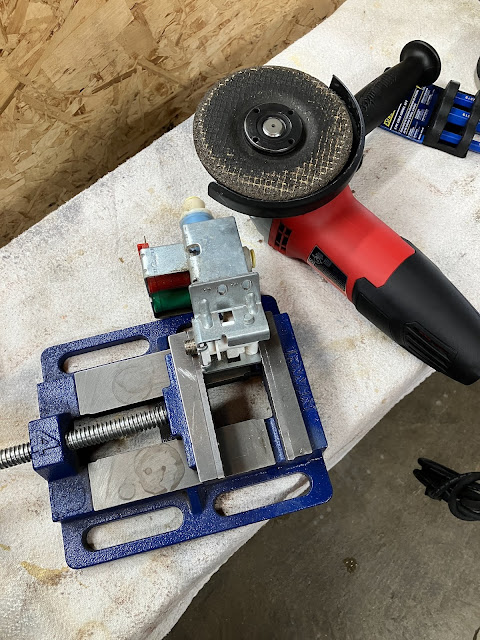You might recall from a previous episode of "Nico's peculiarly random home maintenance adventures" that I did a little bit of replumbing on my sprinkler system, in part to repair a small leak, but also in part to install a water hammer arrestor. I had hoped to quiet some water hammer noise that had been disturbing my sleep in the wee hours of the morning when the sprinklers would cycle on and off.
Of course, the water hammer arrestor I installed did sweet fuck-all to quiet the noise, so it was clearly time to try to solve the problem from the other end, by eliminating the source of the noise rather than eliminating the water hammer.
After a little sleuthing, I determined that it was my fridge that was responsible for generating the noise rather than any plumbing in the walls. This was good news, since, on the one hand, it meant that the noise source wasn't buried in the walls somewhere; and on the other hand, because there are very few components in the fridge between the water inlet and the solenoid valve that could possibly be making any noise.
By which I mean that there are basically no components other than the solenoid valve that could possibly be making any noise.
Now you might wonder how a solenoid valve could make noise from water hammer, and the answer is a bit puzzling if you don't know how a solenoid valve works. Basically there's a (relatively) large diaphragm inside the valve with a small hole in the middle. That hole allows the water to fill the cavity behind the valve, pushing the diaphragm forward and against the valve seat, keeping the valve closed. Then there's a small bypass port, with a pin that's held down over it by a spring, which the solenoid can magnetically retract. By retracting that pin, water from behind the membrane is allowed to bypass the closed valve, which lowers the pressure behind the diaphragm, thus leading to the water pressure on the front of the diaphragm lifting it away from the valve seat, allowing the water to flow through the valve.
So given that the valve is largely driven by water pressure, it's perhaps not surprising that a sudden oscillation in the input water pressure might lead to the valve diaphragm lifting when it shouldn't, causing it to flutter and make a bunch of noise, particularly if the valve is a little bit old and crusty.
Anyway, with that tech talk out of the way, let's get this party started.
By vacuuming up all this dust again...
That's much better.
With a few screws removed, the cardboard cover panel back here swings open, revealing the valve inside.
The red valve controls the water that goes up to the ice maker, while the green valve controls the water that goes to the door dispenser.
Removing two more screws allows us to free up the inlet fitting and valve assembly.
Both the electrical connections and water ports are idiot-proofed luckily: the spades are a different size on the two connectors, and the water tubes are a different diameter. But all the same, it's helpful to take lots of photos as you go.
The water tubes are a simple push fitting. You remove them by pushing inwards slightly, holding the collar forwards, then pulling the tube out.
But this is where things get slightly less simple: the valve body is apparently staked together with the inlet fitting.
So it's a good thing I'm prepared for this sort of situation.
The staked pins are easily ground away.
And a little love tap with a cold chisel separates the two parts. There's no need to re-attach the new valve body since the two pieces are held onto the fridge by the same pair of screws.
Speaking of being held onto the fridge, let's get the new valve in place and hooked up.
And after checking for leaks, we can button up the cardboard cover.
And all that's left to do is push the fridge back into place, which I didn't take a photo of, because it looks exactly like the first picture in this blog post. Go scroll up to the top and look at it again if you can't stand the suspense.
I tried turning the kitchen faucet on and off a couple of times and it's almost eerie not hearing the subtle clunk from the fridge when the pressure wave ripples through the plumbing. Something tells me I'm going to have a good night's sleep tonight.












No comments:
Post a Comment